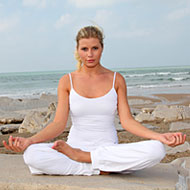Spiritual Yoga
Yoga is normally credited to two great, spiritual stalwarts: Lord Sri Krishna and the sage Patanjali. The Yoga of the sage Patanjali is more popular nowadays and consists largely of 2 parts – Hatha and Raja Yoga.
Let’s understand how it works. According to the Yoga of Patanjali there are 3 limbs and hence it is called Ashtanga Yoga. They are:
- Yama (observances)
- Niyama (restraints)
- Asana (posture)
- Pranayama (breath control)
- Pratyahara (sense withdrawal)
- Dharana (concentration)
- Dhyana (meditation)
- Samadhi (a state of supreme Bliss)
Hatha Yoga (steps 3 and 4) largely deals with the body, its purification and maintenance. Spiritual Yoga, on the other hand embraces all 8 steps and in particular the remaining 6. They constitute the practice of what is called Raja Yoga. This is more in keeping with the teachings (Upadeshas) of the Lord, Sri Krishna in the Bhagavad Gita.
Spiritual Yoga is more concerned with spiritual purity and cleansing and, as such, comprises all those practices that achieve those ends. For this one has to be pure of behavior. Hence the importance of the practice of Yamas and Niyamas. Breathing exercises helps burn the thoughts running through the mind and helps bestow calm and tranquility hence the importance of Pranayama.
This done, the Yoga practitioner, willfully, withdraws – his her / interest – from sense objects and sensory pleasures. Again a reflection of the teachings of Sri Krishna in the Bhagavad Gita: “only he who revels in the joy of the Self, abides by the Self, relies on the Self for everything………is a true Yogi, Oh Arjuna”
Withdrawal of the senses facilitates the practice of concentration and then meditation (prolonged concentration). Once the Yoga practitioner is able to sit in meditation, the rest comes easily. Almost of its own accord. Then again, Spirituality is an evolving process, so there is no saying when one has reached the summom bonum of life.
Read more articles from the About Yoga Category.

 Find Pose
Find Pose

